Menu
Close

What is emotional literacy? Understand your emotions, understand yourself
May 3, 2021
Emotions play a huge role in our lives, our actions and our relationships. Yet, most of us know surprisingly little about what they are, how we experience them and why we have them in the first place. Some psychologists might say we’re low on “emotional literacy.”
This lack of emotional literacy leaves us ill-equipped to manage the variety of emotions we experience on a normal day, let alone during a pandemic. Focusing on naming, expressing and dealing with our emotions — the ones we like and the ones we don’t — is important for our mental health. By learning more about your emotions and how to name them, express them, and deal with them, you can use them to better navigate your daily life, make better decisions and feel more at ease.
What are emotions?
Emotions are sort of like our internal road signs or stoplights, but with the lights flashing in different parts of our bodies in different ways. There’s a subjective part, which is how you feel in the moment — what we might call happiness, sadness or fear. There’s a physiological component, which is how your body reacts to what you’re experiencing (clenched teeth? squeals of delight?). And then there’s often a behavioural component, which is the action you take in response to how you feel.
How are emotions felt in the body?
Emotions physically manifest themselves in a variety of ways. Your breathing or heart rate might speed up or slow down. Your body temperature might rise or fall, leading you to feel warm or cool. Your facial expressions and body language might change — furrowing your brow and slumping your shoulders when you’re feeling frustrated, for instance. And finally, emotions might trigger movements, like tapping your foot or twirling your hair when you’re feeling nervous or impatient.
Why do we have emotions?
First and foremost, emotions are thought to serve an evolutionary purpose. Our ancestors who felt fear and ran away (red light!) when they saw tigers survived, while those who felt nothing did not.
Another way to put it would be to think of emotions as motivators. We are motivated to do things that lead to comfortable emotions (green light!) and avoid doing things that lead to uncomfortable emotions. Once again, this plays a key role in our survival, leading us to seek out food, avoid danger and reproduce.
Emotions also help us communicate and collaborate with others, and therefore play a key role in helping our society run smoothly.
How does naming our emotions help?
Putting our feelings into words can reduce the intensity of negative emotions and make them more manageable.
For example, in a study of people with a spider phobia, researchers found that when participants described the anxiety they were feeling in the presence of a giant tarantula, they were better able to manage their anxiety when they were exposed to the tarantula one week later. In fact, the participants who described their anxiety in greater detail actually experienced the least amount of anxiety, including dulled physical responses like less sweaty palms.
Putting feelings into words is thoughti to decrease activity in the amygdala, the part of the brain that drives our responses to fear and stress, and increase activity in the prefrontal control regions, parts of the brain associated with regulating and making sense of emotions.
How emotions connect us with others
According to emotion scientist Marc Brackett, the Founder and Director of the Yale Center for Emotional Intelligence, labeling our emotions also helps us describe what we’re going through, which helps us get help from others. We can’t empathize without being in touch with how we’re feeling ourselves, so this language of emotions helps us provide support that matches what someone is feeling, foster connections, commiserate and solve problems together.
By better understanding our emotions, becoming more aware of their effects and labelling them more accurately, we’re better able to make sense of how we’re feeling and act in ways that contribute to greater emotional wellbeing. That’s the power of getting real about how you feel.
If your emotions are overwhelming, persistent and/or are interfering with your daily functioning, it’s important to seek mental health support.
Sources:
https://plato.stanford.edu/entries/emotion/
https://www.scn.ucla.edu/pdf/Torre(2018)ER.pdf
https://www.marcbrackett.com/a-word-is-a-world/
Affect Labelling Lieberman, M. D., Eisenberger, N. I., Crockett, M. J., Tom, S. M., Pfeifer,J. H., & Way, B. M. (2007). Putting feelings into words: Affect labeling disrupts amygdala activity in response to affective stimuli. Psychological Science, 18(5), 421–428. doi:10.1111/j.1467-9280.2007.01916.x
